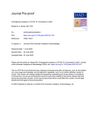TLDR AGA linked to worse COVID-19 outcomes in men.
This document discusses the correlation between androgenetic alopecia (AGA) and COVID-19 outcomes. Several studies have found that AGA is more prevalent in COVID-19 patients than in the general population, and that the presence of the Gabrin sign (a skin manifestation of COVID-19) is associated with a higher prevalence of AGA. The severity of AGA, as measured by the Hamilton-Norwood scale, is also associated with worse outcomes in hospitalized men. The document suggests that AGA may be a risk factor for severe COVID-19 outcomes in men, and encourages further research on the topic.
 6 citations
,
July 2020 in “Journal of The American Academy of Dermatology”
6 citations
,
July 2020 in “Journal of The American Academy of Dermatology” Hair loss link to severe COVID-19 unclear.
 119 citations
,
May 2020 in “Journal of The American Academy of Dermatology”
119 citations
,
May 2020 in “Journal of The American Academy of Dermatology” Most COVID-19 patients in hospitals have androgenetic alopecia, more in men, suggesting a link between androgen sensitivity and severe COVID-19 symptoms.
 123 citations
,
May 2020 in “Drug Development Research”
123 citations
,
May 2020 in “Drug Development Research” Men's sensitivity to male hormones might affect how severe COVID-19 gets for them.
 155 citations
,
December 2003 in “British Journal of Dermatology”
155 citations
,
December 2003 in “British Journal of Dermatology” Hair loss increases with age; alcohol raises risk, more female partners lowers it.
 2 citations
,
August 2020 in “Journal of The American Academy of Dermatology”
2 citations
,
August 2020 in “Journal of The American Academy of Dermatology” High incidence of hair loss found in COVID-19 patients, but no severity correlation established.
 January 2025 in “International Journal of Trichology”
January 2025 in “International Journal of Trichology” Severe hair loss may increase the risk of dying from COVID-19.
1 citations
,
March 2022 in “Irish Journal of Medical Science” Men with androgenetic alopecia and hypertension may experience more severe COVID-19.
 119 citations
,
May 2020 in “Journal of The American Academy of Dermatology”
119 citations
,
May 2020 in “Journal of The American Academy of Dermatology” Most COVID-19 patients in hospitals have androgenetic alopecia, more in men, suggesting a link between androgen sensitivity and severe COVID-19 symptoms.
 6 citations
,
December 2020 in “Dermatological reviews”
6 citations
,
December 2020 in “Dermatological reviews” COVID-19 may worsen with androgens; anti-androgen drugs could help.








